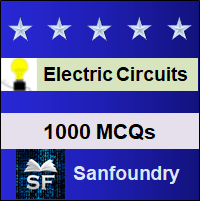
Electric Circuits Multiple Choice Questions Highlights
- 1000+ Multiple Choice Questions & Answers (MCQs) in Electric Circuits with a detailed explanation of every question.- These MCQs cover theoretical concepts, true-false(T/F) statements, fill-in-the-blanks and match the following style statements.
- These MCQs also cover numericals as well as diagram oriented MCQs.
- These MCQs are organized chapterwise and each Chapter is futher organized topicwise.
- Every MCQ set focuses on a specific topic of a given Chapter in Electric Circuits Subject.
Who should Practice Electric Circuits MCQs?
– Students who are preparing for college tests and exams such as mid-term tests and semester tests on Electric Circuits.- Students who are preparing for Online/Offline Tests/Contests in Electric Circuits.
– Students who wish to sharpen their knowledge of Electric Circuits Subject.
- Anyone preparing for Aptitude test in Electric Circuits.
- Anyone preparing for interviews (campus/off-campus interviews, walk-in interview and company interviews).
- Anyone preparing for entrance examinations and other competitive examinations.
- All - Experienced, Freshers and College / School Students.
Electric Circuits Chapters
Here's the list of chapters on the "Electric Circuits" subject covering 100+ topics. You can practice the MCQs chapter by chapter starting from the 1st chapter or you can jump to any chapter of your choice.- Circuit Variables and Elements
- Simple Resistive Circuits
- Techniques of Circuit Analysis
- The Operational Amplifier
- Inductance, Capacitance, and Mutual Inductance
- Natural and Step Responses of RLC Circuits
- Sinusoidal Steady-State Analysis
- Sinusoidal Steady-State Power Calculations
- Balanced Three-Phase Circuits
- Introduction to the Laplace Transform
- The Laplace Transform in Circuit Analysis
- Introduction to Frequency Selective Circuits
- Active Filter Circuits
- Fourier Series
- The Fourier Transform
- Two-Port Circuits
1. Circuit Variables and Elements
The section contains multiple choice questions and answers on units, voltage and current power, electrical resistance, kirchoffs law and circuit analysis for dependent sources.
|
|
|
2. Simple Resistive Circuits
The section contains questions and answers on voltage and current divider circuits, wheatstone bridge measuring resistance.
|
|
|
3. Techniques of Circuit Analysis
The section contains MCQs on node voltage and mesh current method, source transformations, thevenin and norton equivalents, maximum power transfer and superposition.
4. The Operational Amplifier
The section contains multiple choice questions and answers on operational amplifier terminals, inverting and noninverting amplifiers, realistic models.
|
|
|
5. Inductance, Capacitance, and Mutual Inductance
The section contains questions and answers on inductor and capacitor, series parallel combinations, mutual inductance, rl and rc circuits, natural and unbounded responses, sequential switching and integrating amplifier.
|
|
|
6. Natural and Step Responses of RLC Circuits
The section contains MCQs on natural and step responce of parallel and series rlc circuits, integrating amplifiers.
|
|
|
7. Sinusoidal Steady-State Analysis
The section contains multiple choice questions and answers on sinusoidal source and response, phasor, passive circuit elements, kirchoffs law, series and parallel simplifications, thevenin norton equivalent circuits, node voltage method, transformer and ideal transformer, phasor diagrams and instantaneous power.
|
|
|
8. Sinusoidal Steady-State Power Calculations
The section contains questions and answers on average and reactive power, rms value, complex power, power calculations and maximum power transfer.
|
|
|
9. Balanced Three-Phase Circuits
The section contains MCQs on three phase voltage sources, wye delta circuits, three phase circuits and average power.
|
|
|
10. Introduction to the Laplace Transform
The section contains multiple choice questions and answers on laplace transform, impulse function, functional and operational transforms, inverse transforms, poles and zeros, initial and final value theorems.
|
|
|
11. The Laplace Transform in Circuit Analysis
The section contains questions and answers on transfer function, convolution integral, steady state sinusodial response, s domain analysis.
|
|
|
12. Introduction to Frequency Selective Circuits
The section contains MCQs on low pass, high pass, bandpass and band reject filters.
|
|
|
13. Active Filter Circuits
The section contains multiple choice questions and answers on low pass and high pass filters, scaling, op amp filters, narrowband bandpass filters.
|
|
|
14. Fourier Series
The section contains questions and answers on fourier coefficient, applications, rms value of periodic function, amplitude and phase spectra, exponential form of fourier series.
|
|
|
15. The Fourier Transform
The section contains MCQs on fourier transform derivation, fourier integral convergence, laplace transforms, parsevals theorem, circuit applications.
|
|
|
16. Two-Port Circuits
The section contains multiple choice questions and answers on terminal equations and two port parameters, two port circuit analysis and terminated two port circuit.
|
|
|
Wish you the best in your endeavor to learn and master Electric Circuits!
